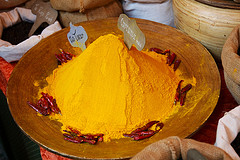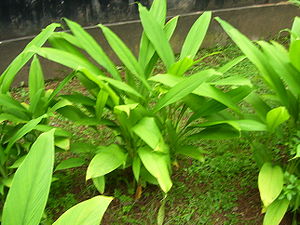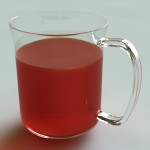- Image via Wikipedia
Turmeric honey is one of my favorite ways to give turmeric. Turmeric is an adaptogen, a nontoxic herb that regulates the immune and endocrine systems. It also is antiseptic, is hepatoprotective, invigorates the blood, and helps prevent or treat infection. Regarded as a panacea in Ayurveda, turmeric is widely used in food, medicine and skin care. Indian curries, Persian dishes like masak lemak, Thai and Indonesian dishes like rendang use curry to color and impart flavor. In skin care, its golden color and medicinal properties enhance dark skin. (I have had people react in alarm when a turmeric foot soak turned my pale legs yellow!) It is used ceremonially throughout South Asia, including Bengali weddings where it adorns the married couple or Pujas where the powder is moistened and formed into an image of Ganesha. Rich in pigments it is used for dyes and to color food. It is one of my favorite herbs.
Turmeric contains up to 5% essential oils and up to 5% curcumin, a polyphenol considered the most active constituient of turmeric, although I think it works best when mixed with its other natural antioxidants including curcuminoids, flavanoids and carotinoids. Volatile oils include tumerone, atlantone, and zingiberone which is also found in the related plant, ginger. Other constituents include Vitamins C and E, sugars, proteins, and resins. It is used in Chinese and Ayurvedic medicine for the treatment of inflammation, flatulence, jaundice, menstrual difficulties, hematuria, hemorrhage, and colic. Turmeric can also be applied topically in poultices to relieve pain and inflammation but will color the skin for a few days after removal.
Turmeric is better absorbed when mixed with other constituents and when used as a whole herb since flavanoids are best served with their synergistic compounds. Pharmacokinetic studies in animals demonstrate that 40-85 percent of an oral dose of the isolate curcumin passes through the gastrointestinal tract unchanged, with most of the absorbed flavanoid being metabolized in the intestinal mucosa and liver. But that refers to the isolates. One manufacturer of curcumin BCM-95®, mixes it back with the original compounds and increases absorbtion 7.8 times more than curcumin alone. (It might be easier to stay with the original herb!) Adding 5% black pepper or long pepper increases availability by 2000%. And most compounds are increased in bioavailability when taken with honey or a fat source like ghee.

- Image by Carlos Lorenzo via Flickr
I have been making turmeric honey for some time now. Although curry powder typically contains both turmeric and pepper, the concentration of turmeric is rather low so I prefer to work with turmeric. I take:
- 9 parts dried turmeric powder
- 1/2 part freshly ground black pepper (grind it finely)
- 1/2 part dried ginger powder
Mix thoroughly. Start adding a liquid honey into the powder. It helps to warm the honey which allows it to absorb better. I usually use a local honey, but a eucalyptus or manuka honey would add additional benefit. Just make sure the honey is not whipped or crystallized because you need it to be runny. Stir, slowly adding the honey until all the powder is dissolved and you have a thick paste. The amount will vary depending on the moisture content of the honey, but a pound of turmeric in honey usually fills a 20 oz jar. The exact proportions are not critical as this is a food grade herb.

- Image via Wikipedia
What is it good for? All kinds of things. If you suffer from arthritis, back pain or any kind of joint pain, this helps reduce the inflammation. I suggest it to most clients who suffer from autoimmune disease as it reduces flares when taken consistently at a teaspoonful per day. I had one client who suffered from large lipomas in her arms- after 6 months they had shrunk from softball size to golf ball size. If your C-reactive protein levels are high, indicating inflammation, this can frequently lower them. It is useful for reducing symptoms of crohn’s disease, lupus, RA, fatty liver, hepatitis and to prevent gallstones. Turmeric helps detoxify so is useful after exposure to industrial or household toxins. It can be mixed with warm milk or nutmilks for children coming down with an infection. You can mix it with other herbs or use the turmeric honey alone.
Turmeric honey can be use topically on sores and ulcerations, although I would thin with honey or water. In India, turmeric powder is frequently applied to cuts, and honey also is used in this manner. You can use it as a soak for skin conditions, at least if you don’t mind the color.
When I discussed this with David Winston, he suggested that ghee might be substituted for honey for diabetic clients (who typically suffer from high levels of inflammation.) You can melt ghee over a low flame and mix with the powders. It will have a more bitter taste, and intuitively I think that the honey helps with assimilation. If you want to reduce the honey, try one part melted ghee to two parts honey and stir well- adding a spoonful of lecithin will help mix the two liquids before you add the turmeric mixture. Just don’t use the same proportion of honey and ghee as this is considered unhealthy in Ayurveda. And you can also thin honey with up to a third hot water to reduce it.
And a totally irrelevant thing to try as long as you have the turmeric out:
Curcumin is used to indicate pH, with a yellow color in the presence of acids and a red color in the presence of bases. The whole herb works too. Take a little turmeric in a clear drinking glass and mix a half glass of water into it. Now add a little lye drain cleaner or a lot of baking soda, and watch it turn a pleasing shade of red. ( I couldn’t make the turmeric turn any yellower than it was with citric acid, so either it has the same color from acid to neutral, or my water is slightly acid.)





Terrific article! We love Turmeric Roots and the many benefits it can provide – this kind of educational reading is exactly what people need.
Hi, I would like to try this but how much honey do I mix with the spices?
Honey varies in consistency so I can’t give you an exact amount. Stir in enough liquid honey to make a cookie dough consistency.